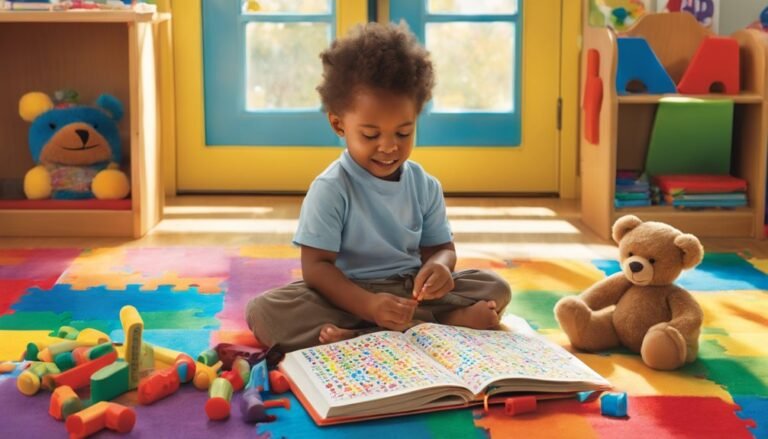Teaching Patience to Toddlers
Did you know that, on average, toddlers have an attention span of just 2-3 minutes? It may seem surprising, but it’s true.
Teaching patience to toddlers is a crucial skill that can greatly benefit their overall development. But how do you go about it?
In this discussion, we will explore effective strategies and techniques that can help you teach patience to your little one. From setting realistic expectations to modeling patience as a parent, you’ll discover practical tips that will not only improve your toddler’s ability to wait but also promote self-regulation and self-control.
So, let’s dive in and uncover the secrets to teaching patience to toddlers.
Key Takeaways
- Teaching patience to toddlers helps with emotional regulation and coping with frustration.
- Patience promotes enhanced social skills, such as taking turns and listening to others.
- Teaching patience improves problem-solving skills and encourages perseverance.
- Setting clear expectations and using visual aids can help toddlers understand and practice patience.
Understanding Toddlers’ Impatience
Understanding why toddlers can be so impatient can help you navigate their behavior with patience and empathy.
Toddlers are at a stage of development where they’re constantly exploring and discovering the world around them. Their curiosity and eagerness to learn can often lead to impatience.
You see, toddlers have a limited understanding of time and lack the ability to delay gratification. This can make waiting for things, like a snack or a turn on the swing, incredibly challenging for them.
There are several common triggers of impatience in toddlers that you should be aware of.
One trigger is hunger. When your little one’s tummy is rumbling, their patience may wear thin.
Another trigger is fatigue. When a toddler is tired, their ability to regulate their emotions and wait patiently diminishes.
Lastly, toddlers often become impatient when they’re in new or unfamiliar situations. The uncertainty and lack of control can be overwhelming for them.
To manage your toddler’s impatience, it’s important to be proactive and prepared.
One strategy is to provide a predictable routine. Having a consistent schedule can help your toddler feel more secure and less frustrated.
Another strategy is to offer distractions. Engaging your little one in an activity or giving them a small toy can help redirect their attention and reduce impatience.
Additionally, acknowledging and validating your toddler’s feelings can go a long way in helping them cope with impatience.
Benefits of Teaching Patience to Toddlers
Now that you understand the triggers of impatience in toddlers, let’s explore the numerous benefits that come from teaching them patience. Cultivating patience in young children is incredibly important and has a lasting impact on their development. By teaching toddlers to be patient, you are equipping them with a valuable life skill that will serve them well as they grow older.
The benefits of teaching patience to toddlers are wide-ranging and significant. Here are just a few:
| Benefits | Description | Example |
|---|---|---|
| Emotional Regulation | Patience helps toddlers better manage their emotions and cope with frustration. | Your child will be less likely to throw tantrums when they don’t get what they want immediately. |
| Improved Problem-Solving | Patience allows toddlers to think through problems and find solutions. | Your child will learn to persevere and find creative ways to overcome obstacles. |
| Enhanced Social Skills | Patience helps toddlers develop empathy and understanding towards others. | Your child will learn to take turns and wait for their friends to finish before speaking. |
| Increased Focus and Attention | Patience allows toddlers to concentrate on tasks for longer periods of time. | Your child will be able to complete puzzles or engage in activities that require sustained attention. |
| Better Self-Control | Patience helps toddlers resist impulsive behaviors and make thoughtful decisions. | Your child will learn to think before acting and consider the consequences of their actions. |
Setting Realistic Expectations
To set realistic expectations for teaching patience to toddlers, it’s important to understand their developmental stage and capabilities. Managing frustration is a key aspect of teaching patience, as toddlers often struggle with expressing their emotions effectively. It’s important to remember that they’re still learning how to navigate their feelings and may not have the vocabulary or understanding to communicate their frustrations clearly. As a caregiver, your role is to provide them with guidance and support, helping them to develop healthy coping mechanisms.
Teaching toddlers about time is another important aspect of setting realistic expectations. Time is a difficult concept for young children to grasp, and expecting them to understand waiting or delayed gratification can be challenging. Instead, try using visual aids such as timers or picture schedules to help them understand the concept of waiting.
For example, you can use a timer to show them how long they need to wait before getting a treat or playing with a toy. This can help them develop a sense of time and gradually build their patience.
Establishing a Consistent Routine
Establish a consistent routine to provide structure and predictability for your toddler’s day. Consistency is key when it comes to establishing a routine for your little one. By following a set schedule, you create a sense of stability and security that helps your toddler feel more at ease and confident in their day-to-day activities.
Here are a few tips to help you establish consistency and create structure in your toddler’s daily routine:
-
Set fixed times for meals and snacks: Having regular meal times not only ensures that your toddler gets the nutrition they need but also helps create a predictable pattern throughout the day.
-
Establish a consistent bedtime routine: A bedtime routine signals to your toddler that it’s time to wind down and prepare for sleep. Consistently following the same steps, such as reading a story or taking a bath, can help them relax and transition smoothly into sleep.
-
Plan regular activities: Incorporate activities like playtime, outdoor time, and learning into your toddler’s routine. Having specific times for these activities helps create a sense of structure and keeps your toddler engaged throughout the day.
Practicing Delayed Gratification
Encourage your toddler to wait patiently for things they want by teaching them the skill of delayed gratification. Practicing delayed gratification is an essential part of developing impulse control, which will benefit your child throughout their life. Delaying gratification means resisting the temptation of immediate rewards and waiting for a later, often greater, reward.
One way to practice delayed gratification is through structured activities that require waiting. For example, you can play a game with your toddler where you take turns, teaching them that they need to wait for their turn to come. You can also introduce activities that involve setting goals and working towards them over time, such as saving money to buy a special toy or waiting to open presents on special occasions.
It’s important to remember that practicing delayed gratification isn’t about denying your child what they want, but rather teaching them the importance of patience and self-control. By gradually increasing the waiting time and rewarding their efforts, you can help your toddler develop the ability to resist impulsive desires and make more thoughtful decisions.
Incorporating delayed gratification into your daily routine won’t only teach your toddler an invaluable life skill, but it will also help them understand the concept of delayed rewards. So, next time your child wants something immediately, guide them towards delayed gratification and watch them develop their impulse control.
Teaching Toddlers About Waiting
Teaching toddlers about waiting can be a challenging but essential skill to help them develop patience and self-control. As toddlers are naturally impulsive, it’s important to teach them techniques that will help them wait calmly and understand the concept of delayed gratification.
Here are some practical tips to guide you in teaching your toddler about waiting:
-
Set clear expectations: Explain to your toddler that waiting is a part of life and help them understand what it means to wait for something.
-
Teach patience through play: Engage your toddler in games or activities that require waiting, such as taking turns or playing board games. This will help them learn to wait their turn and practice patience in a fun and interactive way.
-
Use visual aids: Utilize visual aids, such as timers or countdown charts, to help your toddler understand the concept of waiting. This will provide them with a tangible representation of time passing and help them develop patience.
Encouraging Problem-Solving Skills
As your toddler develops patience and self-control through learning about waiting, another important skill to focus on is encouraging their problem-solving abilities. By fostering independence and encouraging creativity, you can help your little one become a confident and resourceful problem solver.
One effective way to promote problem-solving skills is through open-ended play. Provide your toddler with toys and materials that allow them to explore and experiment. Encourage them to come up with different solutions and ideas. This type of play stimulates their imagination and helps them develop critical thinking skills.
Another strategy is to involve your toddler in daily tasks and decision-making. For example, let them choose their outfit for the day or ask them to help you solve simple problems around the house. This not only boosts their problem-solving abilities but also gives them a sense of responsibility and independence.
To further support your toddler’s problem-solving skills, you can create opportunities for them to solve puzzles, play memory games, or engage in simple science experiments. These activities not only challenge their thinking but also provide a sense of accomplishment when they find a solution.
Encouraging problem-solving skills in your toddler is an essential part of their overall development. By fostering their creativity and independence, you’re giving them the tools they need to navigate challenges and find solutions throughout their lives.
Promoting Self-Regulation and Self-Control
To help your toddler develop self-regulation and self-control, it’s important to provide them with consistent boundaries and clear expectations. By promoting emotional development and fostering independence, you can empower your little one to navigate their emotions and impulses with greater ease. Here are a few practical ways to support their growth:
-
Encourage emotional expression: Create a safe space for your child to express their feelings. Validate their emotions and help them find appropriate ways to communicate their needs. This will teach them to regulate their emotions effectively.
-
Teach problem-solving skills: Help your toddler develop problem-solving skills by encouraging them to think through situations and come up with solutions. This will empower them to make independent choices and exercise self-control.
-
Establish routines: Consistent routines provide a sense of security and structure for your toddler. Knowing what to expect helps them develop self-regulation skills and reduces the likelihood of meltdowns.
-
Model self-control: Children learn by observing their parents. Show your child how to manage frustration and practice self-control in your own behavior. This will serve as a powerful example for them to follow.
-
Offer choices: Giving your toddler age-appropriate choices allows them to exercise their independence while still operating within the boundaries you’ve set. This helps them develop self-regulation and decision-making skills.
Using Positive Reinforcement and Rewards
Now let’s explore an effective approach to further reinforce self-regulation and self-control in toddlers: utilizing positive reinforcement and rewards.
Positive reinforcement involves providing praise, encouragement, and rewards to encourage desired behaviors. This approach focuses on acknowledging and reinforcing the positive actions that toddlers exhibit. It helps them understand what behaviors are expected and motivates them to continue behaving in that way.
When it comes to using positive reinforcement, it’s important to be specific and timely in your praise. Instead of just saying, ‘Good job,’ try saying, ‘Great job sharing your toys with your friend!’ This helps the toddler understand exactly what behavior is being praised.
It’s also important to provide immediate reinforcement, so the toddler can make a connection between their behavior and the reward.
Rewards can be a powerful tool in reinforcing positive behavior. They can be simple, such as a sticker chart, where the toddler earns a sticker for each instance of desired behavior. When they accumulate a certain number of stickers, they can receive a small prize or a special privilege. This gives them something to work towards and creates a sense of accomplishment.
Modeling Patience as a Parent or Caregiver
One effective way to teach patience to toddlers is by setting a positive example as a patient and calm parent or caregiver. Children learn by observing and imitating those around them, so modeling patience is a powerful tool in their development.
Here are some practical parenting techniques to help you model patience and foster your child’s patience development:
-
Practice self-awareness: Be mindful of your own reactions and emotions. Take a deep breath and remind yourself to stay calm in frustrating situations.
-
Use positive language: Instead of getting frustrated and raising your voice, use gentle and positive language to communicate with your child. This will help them understand how to express their emotions constructively.
-
Example: Instead of saying ‘Stop crying!’ try saying ‘I understand that you’re upset. Let’s talk about it.’
-
Example: Instead of saying ‘Hurry up!’ try saying ‘Take your time, we’ve plenty of it.’
Seeking Support and Guidance From Professionals
Seeking support and guidance from professionals can be a valuable resource for parents and caregivers looking to enhance their understanding of patience development in toddlers. Building a supportive community around you is crucial in navigating the challenges of parenting, and professionals can offer the knowledge and expertise needed to address specific concerns.
When it comes to teaching patience to toddlers, professional advice can provide practical strategies tailored to your child’s unique temperament and development. These experts have a deep understanding of child psychology and can guide you on fostering patience in your little one. They can help you identify triggers that may lead to impatience and offer effective techniques to manage tantrums and frustration.
Moreover, seeking professional guidance can give you peace of mind, knowing that you aren’t alone in your journey. Parenting can sometimes be overwhelming, and having someone to turn to for support and guidance can make a world of difference. Professionals can offer reassurance, empathy, and encouragement, reminding you that you’re doing your best and that it’s okay to ask for help.
Frequently Asked Questions
How Can I Teach My Toddler Patience While They’re in the Middle of a Tantrum?
When your toddler is in the middle of a tantrum, teaching patience can be challenging. But there are techniques you can use to manage the situation and help them learn to wait calmly.
What Are Some Common Mistakes Parents Make When Trying to Teach Their Toddlers Patience?
When teaching toddlers patience, some common mistakes parents make include not being consistent and giving in to tantrums. By maintaining a steady approach and not giving in, you can help your little one develop patience skills.
Are There Any Long-Term Effects of Not Teaching Patience to Toddlers?
Not teaching patience to toddlers can have long-term consequences. It’s important to teach patience early on because it helps them develop self-control and better cope with frustration as they grow.
How Can I Encourage My Toddler to Wait for Their Turn During Playtime With Other Children?
To encourage your toddler to wait for their turn during playtime with other children, try these tips: 1) Praise their patience when they wait, 2) Use visual cues like timers, 3) Teach them about sharing and taking turns through games and role-playing.
Can Teaching Patience to Toddlers Help With Their Overall Emotional Development?
Teaching patience to toddlers can greatly benefit their overall emotional development. It helps them learn to manage frustration, build resilience, and develop self-control. Patience is the key to nurturing their emotional well-being.
Conclusion
In conclusion, teaching patience to toddlers can be a challenging yet rewarding journey. By understanding their impatience and setting realistic expectations, you can help them develop important skills for self-regulation and self-control.
Through consistent routines, practicing delayed gratification, and using positive reinforcement, you can foster a sense of patience in their young minds.
Remember, seeking support and guidance from professionals can also be beneficial. So, embark on this delightful adventure of shaping little minds with the art of patience!








